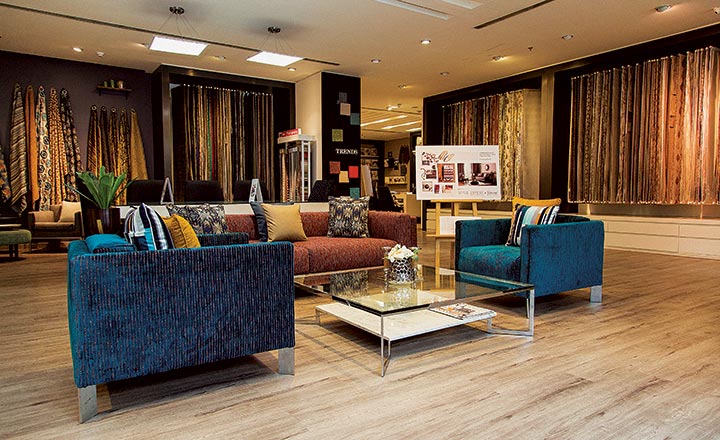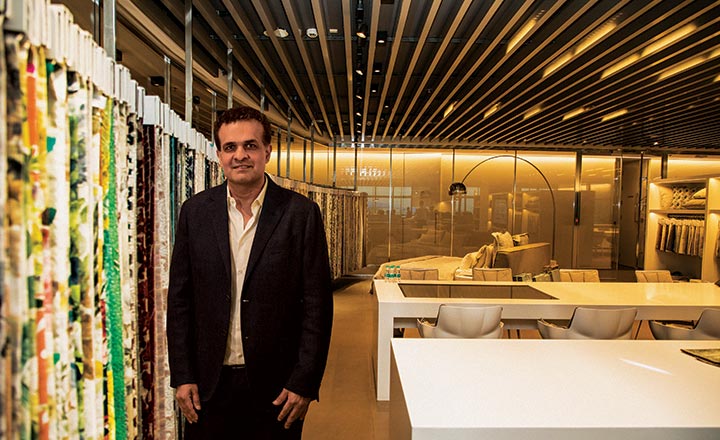Setting is everything — the D’Decor brand takes the tagline from its famous ads, starring one of the most popular couples in the country, seriously. MD Ajay Arora’s spacious office in the high-rise building conveys ambition and quiet confidence — there is the breathtaking view of the city, a tall leather chair, a mahogany desk and a cushy couch for unhurried meetings.
Arora has reason to feel comfortable in his role. “I was born into the apparel-textile business,” he says. The family used to sell fabric for womenswear and make affordable imitation silk in polyester under the name Dicitex. It was a B2B service, worth Rs.700 million in 1995, and today they own a business 30x bigger with total revenue of almost Rs.23 billion. D’Decor has presence in nearly 60 countries including the UK, US and regions in Europe and Middle East.
It is a great comeback for Arora, whose jacquard division in the larger concern tanked in 1996. In contrast, the printed and plain apparel business his father, uncle and brothers had been managing, was doing fine. He chose that low point to scout for new opportunities. Arora researched into what fabrics and designs were selling, and realised that there was a void in the home furnishing market.
But the domestic market did not excite him. Arora learnt that the demand for home furnishing was growing in the international markets. And not one to do anything in half measures, he ventured forth to Heimtextil, Europe’s largest home-textile fair in Frankfurt in 1997. Saloni Nangia, president, Technopak, says that was a good call: “In the home-fashion space, the section of consumers that would have appreciated high quality and differentiation was very small in India in the nineties.” She adds, “Retailers in international markets could buy large volume and pay a good price for a high quality and design-oriented product range.”
And just like the brand ambassadors of D’Decor, Arora has always had his wife Simone by his side. “At the fair in Frankfurt, we saw an exquisite range of home fabrics in many colours and grades, created using innovative techniques,” she says. The two then headed to Como, Italy, where they selected artwork from design houses. They learnt how to value the aesthetic side of the business and studied the practical aspects of it, such as making of fabrics, for months before holding the first exhibition that same year. They replicated artworks on fabric using computer-aided design software. Their collection was sold out and they had orders for nine months. Arora eventually decided to part ways with the apparel division of his family business, and roped in his brother Sanjay Arora, who now heads D’Decor’s distribution business, and his father VK Arora, the current chairman of the company.
Defining Moment
The Aroras participated in different international design shows and increased their customer base worldwide. This was until 2008, when they began considering the domestic market seriously. By then, they had set up three production plants at Tarapur in Maharashtra, spending over Rs.20 billion. So, what changed that year? Arora says there were two turning points.
First, he had signed up for a course on global enterprise in India, organised by the Harvard Business School in Hyderabad. The latest edition of Harvard Business Review kept neatly on one side of his desk is evidence of his appreciation of the institute’s contribution even today. The course was for two kinds of entrepreneurs — a global player looking to enter India and an Indian player looking to launch a business overseas. “We were neither of the two,” smiles Arora. That’s when he decided it was time to give the Indian market a chance.
Second, global markets were reeling under the worst recession in almost a century, while India remained almost insulated. This was testament to the domestic market’s resilience. “We had already started working on our India journey and had changed our business model to align with that,” says Arora.
While D’Decor maintained its B2B export business, it began a B2C model in India. “Once you learn about the trends in the market, you naturally shift towards a B2C model,” notes Pinakiranjan Mishra, partner and leader, consumer products and retail, EY India. With its new business model, the company rebranded itself as D’Decor in 2010. The gamble paid off. Its Indian revenue has been growing at 20% CAGR, crossing the Rs.10 billion mark in FY19. Today, the domestic market contributes 45% of the company’s sales.
Nangia traces the evolution of the Indian consumer, and reasons why this has fared well for D’Decor. “There have been many enablers and influencers over the last decade, such as architects and designers. Consumers are buying homes at a younger age, spending more time and money in creating the right environment at home,” she says. The Indian home furnishing market, growing at 4-5% CAGR, is estimated to be worth Rs.400 billion currently.

D For Design
D’Decor made the most of a changing market but it did more to be a leading name. One was working with European designers on patented designs — the company has copyright and ownership of more than 10,000 designs. Second was bringing robotic warehouse system to India. “Manufacturers here did not invest in building software, designs, intellectual property and IT systems back then,” says Arora. Third was that the company managed to bring in a semblance of order into a sector that is largely run by unorganised players, who service two-thirds of the market.
The company’s management visits international art studios regularly to study the latest trends and buy the IP rights for original art, which is then replicated in their products globally. Currently, the company collaborates with four design houses in Europe and the US. “I also believe that home-textile fashion draws from apparel fashion. So, we watch quite carefully what the haute-couture brands are selling and gather inputs from them,” adds Arora. Over the past few years, he has been observing that a cleaner, more textured look with a dash of design has been trending, and speculates that bold and colourful patterns are just around the corner.
As the creative director-product development, Simone explains the work behind their designs, “We plan the concept before releasing a collection into the Indian market. Based on new trends and market requirements, we decide the fabric quality we need in the new line, as well as the number of designs and colour palette for the season.” D’Decor releases 50 collections a year in India — 35 prior to Diwali and the remaining before March. Meanwhile, for its international market, it has three annual launches; one each for its three exhibitions in January, May and September.
“Colour palettes differ for different regions, cultures and markets. D’Decor’s design house is capable of churning out a wide variety to cater to all our export markets,” says Simone. Currently operating out of five state-of-the-art plants in Tarapur, the company churns out almost 20 million metre of fabric per month.
Five years ago, Simone decided to branch out and launch SIMONE, a luxury home-decor store in South Mumbai, showcasing furniture, fabrics, artefacts, tableware and more. “Being a silent contributor towards D’Decor for over two decades, I wanted to create an identity for myself,” she says.
D for Distribution
Great product differentiation requires a great distribution and inventory system, and D’Decor cracked that right in the beginning. As it became a B2C company in 2010, it eliminated distributors from the picture, as well as the need to store large inventory, with its digital platform. Arora explains, “If you go to a retail store to buy our fabric and place an order, the retailer will take measurements at your home and place that personalised order on the platform.”
He then goes on to describe a warehouse straight out of sci-fi movies. It is something D’Decor is mighty proud of. Once the order is received, a machine at the warehouse cuts that exact quantity, packs it and sends an email to the retailer. This product is then delivered to the customer within 48 hours. With this system, the retailer only has to store the samples and the customer gets to choose from a wider range of D’Decor’s products. “With the swatch-book display, the amount of yardage in the inventory chain has fallen dramatically. It increases efficiency and reduces the operating costs,” observes Nangia.
D’Decor further streamlined this process when it opened its first 2,000 square feet exclusive store in Mumbai, built at a capex of Rs.10 million. Today, they have 30 exclusive outlets in cities including Delhi, Chandigarh, Kolkata and Lucknow, while 1,000 multi-brand outlets (MBOs) sell the company’s products. Arora says that 85% of the business comes from these MBOs but explains the rationale behind opening the exclusive stores, “As a brand, it is very necessary for you to connect with the consumer in your own environment and allow them to experience the brand in its true and pure form.” The company is planning to increase the number of its branded stores by seven to eight each year. Once again, Arora struck the right chord with these stores, as each D’Decor outlet garners sales worth five MBOs.
Mixed identity
While D’Decor is working hard to retain its high-end positioning, there are other names in the higher category such as Atmosphere, Bombay Dyeing and Portico. The company’s curtain fabrics are available at Rs.250-5,000/metre, but yardage from its much more exclusive peers such as Atmosphere can cost up to Rs.15,000/metre.
Harish Bijoor, founder of Harish Bijoor Consults, believes that D’Decor has a yen to become a premium brand, moving upwards in terms of pricing. “By keeping its offering 30% more expensive than the unbranded ones, it placed itself at a mid-market level when it entered. While brands such as Atmosphere fall under the premium category, D’Decor and Bombay Dyeing are popular premium brands,” he adds.
Meanwhile, Nangia says positioning matters as much as pricing. “D’Decor has been seen as a premium aspirational brand since it entered India, when we were importing much of the home furnishing fabric,” she adds. Building its international business first has given the brand an added edge of gilt.
Arora believes the exposure to international markets gave D’Decor more than that; he believes it gave the company an ability to meet requests for high quality and design. “The developed market customer is quite demanding when it comes to innovative designs and service,” he says. The company also had to face cut-throat competition in other markets since there are more than 400 fabric suppliers around the world at D’Decor’s level of pricing. “Only by building strong partnerships and assuring quality did we last for more than 20 years in our international markets,” adds Arora. He shares that 80% of his overseas business, which is still B2B, comes from 30 partners alone.
As far as the branding exercise is concerned, the company spends almost 6% of its revenue on strategising, marketing and advertisement, among others. That brings us to one of the most important reasons why every Indian knows the brand today — Shahrukh and Gauri Khan.
The Bollywood power couple has been a part of D’Decor India through and through. In fact, many consumers believe Gauri is the woman behind the brand, making the expense worth every penny. “We wanted to show how life at home is all about moments with the family. And they are perceived as a successful couple that values family,” explains Arora.
Bijoor also believes D’Decor has earned a degree of ‘brand endorser’ loyalty by not changing their brand ambassadors. “However, Shahrukh is a sunset star now, and I believe the company will move on from him eventually,” he adds.
Besides the star dust sprinkled over the brand, D’Decor has a design ethos that differentiates it from the trend of loud and colourful advertising today. “They advertise in an understated, sophisticated way, which is a conscious choice and part of their personality,” according to KV Sridhar, founder and chief creative officer, HyperCollective, a marketing and advertising company.
The veteran adman says the brand has rightly conveyed its style through ads. “The opulence of D’Decor comes with a distant, refined advertising, which shows less yet conveys more. They are very conscious about quality, be it the paper or the printing quality of their print ads, or the art studio in their video,” Sridhar adds.
Cosy and comfortable
With the name that it has built for itself, Arora is not worried about competition or threat from peers yet. He is of the view that D’Decor has become a brand that has connected with its consumer much better than others in the field. “After becoming a B2C company in India, we’ve learnt a lot about what happens between the gate of the factory and the consumer’s shopping bag. That has allowed us to build our brand to scale,” says Arora.
But, even as it commands a market share of over 20% in the country in the home-fashion space, it is not shutting out the global horizon. He shares that they are planning to launch their B2C model abroad as well. “We’d like to apply the skillset that we have achieved in India on a global scale,” he adds. He says they are in no hurry to win over individual buyers there since the B2B business will remain their focus. The international consumer market for home furnishings is not an easy one to crack, with big names such as Etro Home Collection and Ralph Lauren at one end and start-ups offering affordable chic at the other. D’Decor’s ability to learn from the best and adapt should help the brand ‘Live beautiful’.











